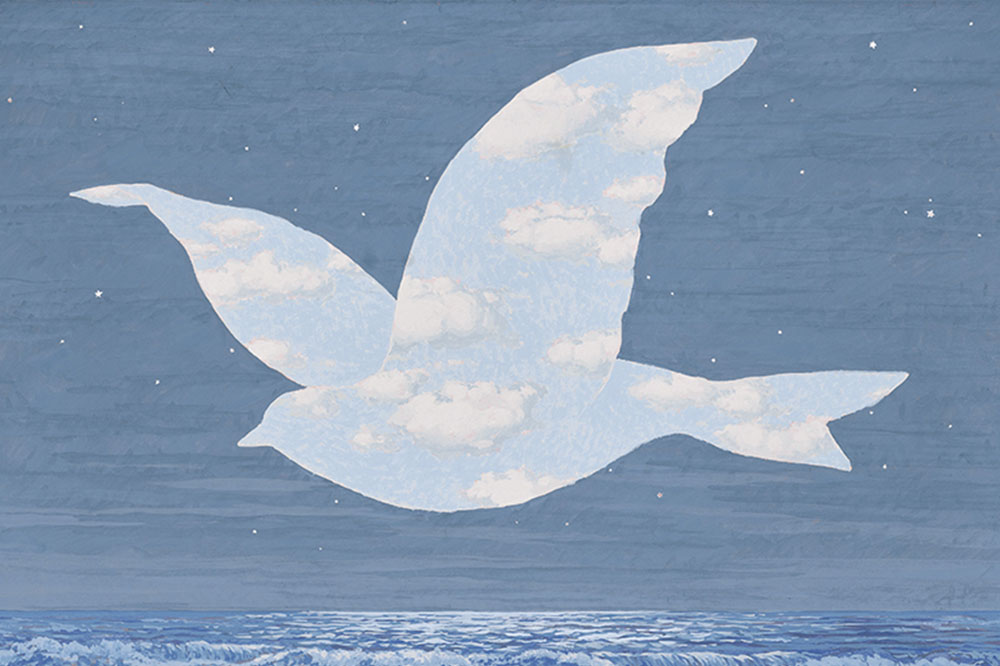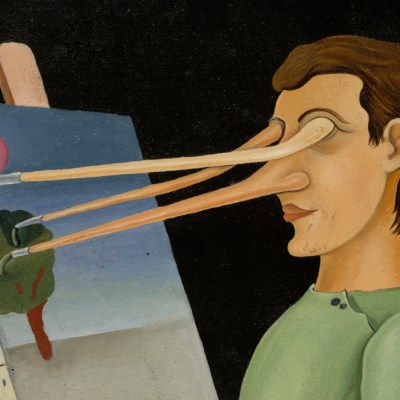From the April 2023 issue of Apollo. Preview and subscribe here.
In 1936 Alfred Barr, founding director of the Museum of Modern Art (MoMA) in New York, mounted one of the first major museum shows of Surrealist art, ‘Fantastic Art, Dada, Surrealism’. His catalogue essay suggests that he would have been surprised at how popular Surrealism still is today. ‘When [Surrealism] is no longer a cockpit of controversy it will doubtless be seen to have produced a mass of mediocre pictures,’ he wrote, as well as ‘a number of excellent works of art, and even a few masterpieces’. It was hardly a ringing endorsement.
Almost 100 years after André Breton’s First Manifesto of Surrealism (1924), Surrealism has never been so visible. There have been sell-out exhibitions at some of the world’s leading museums, prominent displays in the otherwise ultra-contemporary Venice Biennale and fast-rising sales at auction and commercial galleries. There was anticipation in London and Paris last month ahead of the annual Surrealism sales.
Christie’s presented a group of 32 lots in its Art of the Surreal sale in London, including works by some of the movement’s most famous artists, including René Magritte, Salvador Dalí and Max Ernst. There were also paintings by Remedios Varo, Dorothea Tanning and Leonora Carrington, now in the spotlight as a result of rising interest in women modernists. Two weeks later Sotheby’s presented a group of 23 paintings in its Surrealism & Its Legacy sale in Paris, including works by Magritte, Dalí and Francis Picabia.
Christie’s overall did the better of the two houses. A gouache by Magritte of a white bird on a blue background, Le retour (c. 1950), set a record for the artist in that medium, selling for just over £6m (estimate £4m–£6m) – in 2022 only 10 works on paper sold for over $1m (£800,000). Another small painting by the artist, Souvenir de voyage, 1958, sold for £5.6m (estimate £2.5m–£3.5m); in 2009 it had sold at Sotheby’s in London for less than £750,000. A meticulously painted, fantastical oil on Masonite by Varo, Retrato del Doctor Ignacio Chávez (1957) sold for £3.9m (estimate £2.5m–£3.5m). Works by lesser-known but important figures, including the Austrian-Mexican artist Wolfgang Paalen and the Spanish painter Oscar Domínguez, set artists’ records. Sotheby’s, meanwhile, sold a Magritte, La leçon de musique, 1965, for just under €3m (estimate €2.3m–€3.5m), four works by Picabia totalling €4.3m and set an artist’s record for Swiss-American Surrealist Kurt Seligman. His The Alchemy of Painting, 1955, sold for €317,500 (estimate €180,000–€250,000).
The total value of Surrealist art across all auctions at Sotheby’s, Christie’s and Phillips tells the same story, rising from $113m in 2016 to $390m in 2022. The £59.4m paid for Magritte, L’empire des lumières (1961) at Sotheby’s in London last year – a record not just for his work but for any Surrealist painting – finally brought a Surrealist artist up to the prices paid for the most sought-after American Abstract Expressionists.
A new report released last month shows the number of Surrealist works selling for more than $1m has also jumped, from 38 in 2021 to 61 in 2022. The wealthiest collectors ‘are moving from thematic collecting to seeking out the best examples by a diverse array of artists’, says Brooke Lampley, Sotheby’s global head of fine art sales. ‘Maybe they used to collect contemporary art, but now “contemporary art” also encompasses the best works by Frida Kahlo or René Magritte.’
While Surrealism is usually considered a historical movement, a growing number of contemporary artists appear to have been influenced by it. They include many who currently do well at auction. At Sotheby’s The Now evening auction in London last month paintings by Ewa Juszkiewicz, Guglielmo Castelli, Emma Webster, Shara Hughes and Louis Fratino all sold over their upper estimates. Trees (2019), a painting by Swiss artist Nicolas Party sold for £1.4m (estimate £900,000–£1.3m). In 2018 he was invited by the Musée Magritte in Belgium to create new works ‘in dialogue with Magritte, an artist who has made a deep and lasting impression on him’, according to the museum.
An Evening Constitutional (2023) Alyina Zaidi. Modern Art, London, price undisclosed. Photo: Ben Westoby; courtesy the artist and Modern Art, London

Across town in Clerkenwell, Stuart Shave’s Modern Art gallery mounted an altogether more esoteric exhibition of more than 40 Surrealist, ‘visionary’ and contemporary artists on a landscape theme. ‘The Moth and The Thunderclap’ (named after a painting by Charles Burchfield) presented the British Surrealist Ithell Colquhoun’s mystical painting of a Cornish cove, Stalactite (1962), alongside work by more recent artists: Justin Caguiat, Jane Hayes Greenwood, Haroun Hayward, Kinke Kooi, Ever Baldwin and Alyina Zaidi. The art on show was described by its curator, Simon Grant, as ‘spectral dreamscapes, cosmological fantasies, celebrations of personal mythologies, surreal responses to a heightened sense of reality or simply personal responses to a direct experience of the natural world’. Perhaps the multiple ways in which Surrealism can be read and appropriated are part of its enduring popular appeal.
Surrealism emerged out of the devastation of the First World War and the flu pandemic of 1918. André Breton, who would codify Surrealism in a series of manifestos and essays, was traumatised by his experience as an orderly in a psychiatric hospital, dealing with shell-shock cases, while the French poet Paul Éluard and the German artist Max Ernst fought on opposite sides of the trenches.
By the 1940s Surrealism appeared to be a spent force, its energy dissipated as its main proponents fled Nazi Europe. Or so said the standard art histories, inspired by formalist American critics who saw modernism in art as a straight line stretching from Impressionism to abstraction. Chief among these was Clement Greenberg, who – while sparing abstract Surrealists such as Miró and Jean Arp – dismissed their figurative counterparts for producing ‘academic art under a new literary guise’. Although the influential art historian William Rubin disagreed, in his major show ‘Dada, Surrealism and Their Heritage’ at MoMA in 1968 he still presented Surrealism as merely a forerunner of subsequent developments in America in Abstract Expressionism and Pop art. It possibly didn’t help that by then Salvador Dalí, the most famous of all Surrealists, was busy cashing in with commercials and trashy publicity stunts. As recently as 2010, the critic Jed Perl described Dalí’s paintings from the 1940s onwards as ‘god awful’ and ‘the junk food of art’.
‘It is hard not to blame Greenberg, though it was also the state of the times,’ says Wendi Norris, a San Francisco-based art dealer who specialises in Surrealism. ‘When I started working with [Leonora] Carrington and Walter Gruen [the widower of Carrington’s friend Remedios Varo], art was conceptual and the art world was not inclusive. You could be scoffed at simply for making figurative art, let alone being a woman.’
All that has changed. Figurative art is far from despised, while a series of international exhibitions are rewriting Surrealist history. In 2022, the Venice Biennale – the most important contemporary platform of all – placed Surrealism at the centre of the exhibition. The idea, its curator Cecilia Alemani said, came out of lockdown discussions with contemporary artists. ‘Many are using the tools of Surrealism – connecting to the oneiric, the unconscious – not as escape into dreams, but to talk about the current condition,’ she said. ‘Surrealism was a very political movement. I’m not saying that a contemporary artist like, say, Christina Quarles was directly influenced by Ithell Colquhoun or Leonor Fini, but that 80 years apart they are using similar methodologies to tackle similar crises.’
Alemani says she owed a debt to another exhibition, ‘Fantastic Women’, mounted in 2020 by the Schirn Kunsthalle Frankfurt and the Louisiana Museum of Modern Art in Denmark. The show placed women such as Carrington, Tanning, Louise Bourgeois and Frida Kahlo at the centre of Surrealism’s story. Meanwhile, during the Venice Biennale, the Peggy Guggenheim Collection presented ‘Surrealism and Magic’, a relatively under- explored aspect of the movement. At Den Frie in Copenhagen – site of the 1935 International Exhibition of Surrealism – ‘Another Surrealism’ placed historic artists side-by-side with contemporary practitioners including Isa Genzken and Sylvie Fleury.
Installation view of ‘Another Surrealism’ at Den Frie Centre of Contemporary Art, Copenhagen, in 2022. Photo: David Stjernholm

Arguably most influential of all, in 2021 and 2022 the Metropolitan Museum of Art and Tate Modern mounted their own magnum opus: ‘Surrealism Beyond Borders’. Seven years in the making, it presented Surrealism as a global movement encompassing the Caribbean, North Africa, the Near East and East Asia, and spanning more than 60 years from the 1920s into the ’80s. The show was ‘an important step – at once smart and bold – towards a decolonial account of European modernism,’ wrote the art historian Hal Foster.
But with so much attention in the past few years, can interest in Surrealism maintain this momentum? If the first sales of the year are anything to go by this is not guaranteed. Despite some notable prices, Christie’s Art of the Surreal sale was considered stable rather than spectacular overall, with a total of just under £39m for 32 works, compared with 2022’s £40m for 21. Sotheby’s sale in Paris did considerably less well than the equivalent sale the year before, totalling €16.98m compared with €32.9m (in both cases for 23 lots). It probably suffered from the fact the sale included none of the current in-demand female Surrealists. By contrast, in Sotheby’s (Women) Artists sale a day later in London, a 1965 painting by Belgian Surrealist Jane Graverol, L’esprit saint, flew past its £60,000–£80,000 estimate to make £508,000.
New York-based dealer Emmanuel di Donna said that sales are often slow in the early part of the year, especially ‘when things do not feel [economically] so good’. He added that ‘There is a lot of money out there for the right pictures’ – especially female Surrealists – but owners now need a big offer to be tempted to sell.
Whatever happens in the markets, there is no sign of curatorial interest waning. There are still major Surrealist exhibitions ahead, most notably at the Art Institute of Chicago, which after its current Dalí retrospective presents in July a show devoted to Remedios Varo. Insiders say a slew of big museum shows – all still under wraps – are planned for 2024, the centenary of Breton’s manifesto. Most tantalisingly, the Centre Pompidou in Paris, the most important contemporary museum in the city most closely associated with the movement, is rumoured to be among them.
Meanwhile, the public has always loved Surrealism – whether it is in or out of critical fashion. Crowds flocked to MoMA for its shows in 1936 and 1968. In 2019, Tate Modern was surprised by the popularity of its retrospective of Dorothea Tanning, scheduled alongside an exhibition of the much better- known and more bankable (or so it thought) Pierre Bonnard. With another big anniversary ahead, it seems the Surrealist wave has not yet broken.
Original data and analysis for this article was produced by the London-based research firm ArtTactic.
From the April 2023 issue of Apollo. Preview and subscribe here.



